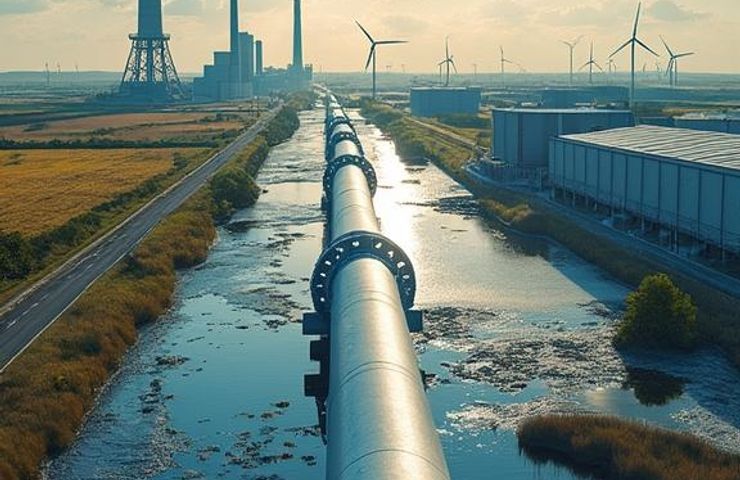
Hydrogen Infrastructure: Cadent Unveils 140 km East Coast Pipeline with £96 m Ofgem Boost
October 17, 2025Cadent Gas just secured a cool £96 million from Ofgem on 20 June 2025 to turbocharge the engineering design, planning, and public consultation for a keystone piece of the UK’s hydrogen infrastructure—a brand-new 140 km stretch of the East Coast Hydrogen Pipeline. This isn’t just any old pipeline: it’s the missing link between Humberside’s energy-hungry industrial hubs and the East Midlands, folding into a network that already threads through northeast England, the Humber, and Yorkshire. The goal? Swap out natural gas for low-carbon hydrogen in everything from steelmaking to chemical plants.
This phase is a huge milestone for the broader East Coast Hydrogen project—a coalition spearheaded by Cadent Gas, National Gas, and Northern Gas Networks. What started with 37 partners back in December 2021 has ballooned to 122 today, bringing together everyone from hydrogen producers to major manufacturers, airports, hospitals, and local councils, all chasing the same net-zero dream.
The East Coast has been an industrial workhorse for decades—blast furnaces, chemical reactors, brick kilns—you name it, they’ve run on natural gas. With electrification hitting a wall in super-hot processes, hydrogen is the only scalable zero-emission option for these tough-to-crack sectors. That’s why this project sits at the heart of the UK’s industrial decarbonization efforts.
Bridging Production and Demand
In real-world terms, this pipeline will shuttle both green hydrogen (made via electrolysis) and blue hydrogen (from steam methane reforming with carbon capture). The region has around 11.6 GW of planned hydrogen production capacity—anchored by sites like HyMarnham Power, which stole the spotlight in the first Hydrogen Allocation Round. By piping hydrogen directly into steel mills, chemical works, brick factories, food & drink plants, and power stations, we can finally kick natural gas to the curb in the processes that just can’t flip to electric heating.
But laying hydrogen pipes isn’t a plug-and-play job. You need special alloys and protective coatings to keep the metal from turning brittle. The design cleverly marries upgraded sections of old natural gas trunk lines with a fresh 140 km build, guaranteeing pressure integrity and a seamless fit into existing corridors. Future recompression stations and real-time monitoring will keep things humming, no matter whether the route hugs coastlines or climbs through valleys.
Strategic Implications
Ofgem’s £96 million endorsement isn’t just a cheque—it’s a policy green light. It dovetails with a broader £500 million UK commitment to regional hydrogen transport and storage, all steering toward net-zero by 2050 (with key check-ins by 2030). By stacking green hydrogen and blue hydrogen sources, the project partners are hedging against supply hiccups and kickstarting a diversified hydrogen market.
Here’s the lowdown:
- Money Moves: Ofgem backing fast-tracks FEED studies and planning.
- Jobs and Growth: Existing plants can switch fuels instead of shutting down, while fresh roles in green skills, pipeline engineering, and more crop up.
- Decarbonization: Targets those hard-to-electrify industries, slashing CO₂ and local pollutants like NOₓ and SOₓ.
Consortium Momentum and National Vision
With 122 members—from global industrial heavyweights to regional councils—the costs and expertise spread out nicely. This initiative also feeds into National Gas’s Project Union, which imagines a 1,500-mile hydrogen superhighway across Great Britain by 2035. Think of East Coast Hydrogen as the launch pad, working in concert with schemes like HyNet up in the North West and Capital Hydrogen in London.
Economic and Environmental Ripple Effects
Beyond slashing factory emissions, this pipeline underpins regional prosperity. It secures thousands of existing jobs in steel, chemicals, glass packaging, and food processing, and it sparks new openings in engineering, environmental assessment, and maintenance. Reports show that when heavy industry switches to hydrogen, carbon footprints dive—and local air quality gets a serious upgrade, benefiting public health.
On the energy security front, reducing dependence on natural gas imports makes the UK more resilient. As renewables ramp up, excess power can be stashed as hydrogen—maybe in old North Sea caverns—and tapped when demand spikes. Smaller players like farms, hospitals, and data centres could soon plug into this ever-expanding hydrogen ecosystem.
Community, Regulation and the Road Ahead
The Ofgem award unlocks Front-End Engineering Design (FEED), but the real test comes next: public consultations, land access deals, and environmental permits. Farmers, residents, and local authorities will pore over route plans and noise studies. Getting this right—swift approvals paired with genuine community engagement—will prove the UK’s regulatory agility.
Pipelines are slated for phased commissioning between 2026 and 2030, with the first hydrogen deliveries expected in the early 2030s, once the final business models for hydrogen transport get government sign-off.
Unlocking Future Hydrogen Hubs
As the main artery takes shape, side spurs could feed industrial parks, airports, and refuelling stations for hydrogen fuel cells. Ambitions for clean ammonia production—combining hydrogen with captured CO₂—could tap directly into the network, opening new markets in fertilisers and shipping. Seasonal storage in offshore or onshore cavities will smooth out supply fluctuations and boost grid stability.
Skill Development and Workforce Transition
Scaling up this kind of hydrogen infrastructure means retraining a workforce steeped in natural gas know-how. Engineers and technicians will learn new welding techniques for hydrogen-compatible alloys and undergo specialised safety training. Cadent Gas’s Ten-Point Plan lays out apprenticeships and partnerships with technical colleges, but timing is key: if upskilling moves too slowly, construction teams hit a bottleneck; too fast, and budgets feel the squeeze.
At its core, the East Coast Hydrogen Pipeline is more than pipes and valves—it’s ground zero for the UK’s approach to industrial decarbonization. If the project stays on track and communities stay onboard, we’ll see hydrogen shift from promising pilot to everyday reality. It’s a blueprint for future green hydrogen and blue hydrogen networks, offering lessons on technical standards, financing, and stakeholder collaboration. As the UK moves from design to digging, all eyes will be on fine-tuning tariffs, locking in storage options, and syncing with the grid. Keep an ear out this autumn for the final business model consultations—they’ll set the stage for the next wave of contracts and investments. The coming years will reveal if Britain can not only build, but truly scale, its hydrogen infrastructure to meet its climate ambitions.



 With over 15 years of reporting hydrogen news, we are your premier source for the latest updates and insights in hydrogen and renewable energy.
With over 15 years of reporting hydrogen news, we are your premier source for the latest updates and insights in hydrogen and renewable energy.